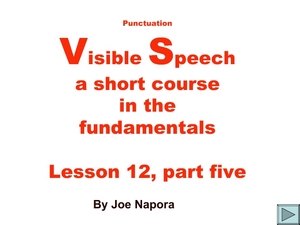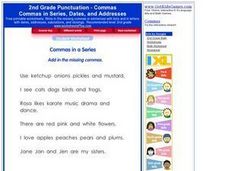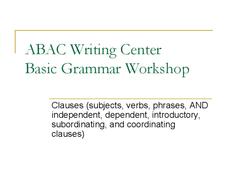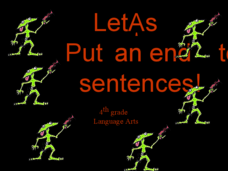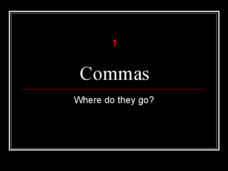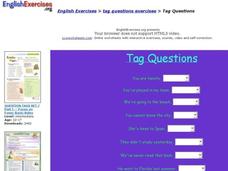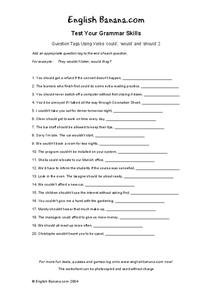Curated OER
Generating Number Sequences
Practicing number sequences, learners solve 5 various problems that include determining various number sequences in each. First, they work out what number comes out of each of the given machines. Then, students write down the first five...
Curated OER
Punctuation: Visible Speech
Examine the proper uses of punctuation with this easy PowerPoint. Simple, bold, and straightforward, each slide introduces a different symbol. Difficult or confusing instances are indicated as well.
Curated OER
Second Grade Punctuation - Commas
Practice punctuating sentences with commas with this series of worksheets! At first glance this resource looks to be one worksheet about using commas in a series. However, you can click "different words" to get a different worksheet....
Curated OER
Clauses
Look at the basic parts of a sentence with your class. Definitions of the subject, verb, and various clauses are all included. Clear, succinct examples are given in this thorough presentation. A great way to start off grammar with your...
Curated OER
Fragments, Comma Splices, and Fused Sentences
Identifying when to use commas, semicolons and other forms of punctuation can be difficult for students. This 10 question activity which relates to sentence fragments, could be used to help students identify correct use of punctuation.
Curated OER
Let's Put an End to Sentences!
Freshen up your fourth graders' memories with this 24-slide PowerPoint on punctuation marks. A brief review of the period, question mark, and exclamation mark is presented prior to the interactive quiz. Students must choose the proper...
Curated OER
Clutter Busters
Commas, colons, and semicolons truly are the "clutter busters" of the written world. Students see many examples of how each are properly used, then must identify the sentence in each slide that uses these punctuation marks in the correct...
Curated OER
Interjections
Teach your class that they can use interjections to make their writing more interesting. Individuals read a selection of sentences from their book using great expression and then explain to the teacher how interjections can make their...
Curated OER
Commas: Where Do They Go?
Help your class use commas properly using this resource. Learners discuss the use of commas in a list, before a conjunction, and as part of a qualifying statement. At the end of the presentation there is a quiz.
Curated OER
Tag Questions with "Be"
A quickie-clickie, online interactive matching exercise has learners choose the correct tag to turn each of 10 declarative sentences into questions. Answers are available at the click of a button, and learners don't need to even attempt...
Curated OER
Question Tags Using Verbs Could, Would, and Should - 2
Help your English language learners develop grammar skills! There are 20 questions, and for each question the learner must use a question tag including could, would, or should. An answer sheet is included.
Curated OER
ESL: Tag Questions
Review tag questions with this short quiz. It's an online quiz, so you'll have to bring your class to the computer lab to have them complete it. There are nine questions, and learners must complete each with its appropriate tag.
Curated OER
Tag Questions: Has he? Hasn't he? Had he?
Your English learners can use an online, interactive worksheet to choose the correct question tag to transform 10 declarative sentences that use the verb to be into interrogatives. They must know to switch the value...
Curated OER
Test Your Grammar Skills
Question tags are tough for English language learners. Print this practice sheet to help them use could, would, and should correctly. Twenty questions make up this worksheet, and an answer page is included.
Curated OER
Question Tags Practice
Young grammarians complete 20 interrogative sentences by adding formulaic question tags. They use the verbs could, would or should with an appropriate pronoun in question tags to complete each sentence. Example: They would...
Curated OER
Question Tags
This resource assesses learners on their knowledge of question tags and their placement in sentences. Six multiple-choice questions are provided, and learners must select the appropriate answer for each. A detailed answer guide is also...
Curated OER
Does She? Doesn't She? Did She?
Designed for English language learners, this online, interactive activity has kids work with the phrases does she, doesn't she, and did she to complete 10 questions. Each answer is available directly below the question by clicking...
Curated OER
Using a Comma to Answer Yes or No
Commas set off words. Review this concept with your beginning grammarians, and then give them this practice opportunity to drive the point home. There are several examples as well as a short passage with a list of accompanying...
Curated OER
Practice With Commas
The instructions say to put commas where they belong, and that is just what your class will do as they practice comma placement and use. There are 20 sentences in desperate need of commas and four extensions exercises where comma use is...
Curated OER
Commas in a Series
Even though this presentation is only five slides long, it provides an excellent overview of how commas should be properly used in a series. Good examples are given, then the last two slides have learners insert commas where necessary....
Curated OER
Other Uses for Commas
Comma usage, in direct address or in appositives, is the subject of a one-page instructional activity that begins with definitions, provides examples, and then asks learners to demonstrate their understanding in sample sentences.
Curated OER
Commas Exercise
In this commas worksheet, students identify where to correctly add a comma in fifteen given sentences. He was a bashful dopey sleeping dwarf, is one example.
Curated OER
Sentence Combining
After a demonstration by the teacher of how to combine sentences, groups read a story loaded with short, choppy sentences and work together to combine sentences to create a more interesting tale. They record their version on a...
Curated OER
Adjective Clauses Using That and Which
An online lesson that clearly, if exhaustively, explains when to use "that" or "which" to begin a relative clause, specifies exceptions to the rule, and notes when to set off such clauses with commas. Learners assess their mastery...



